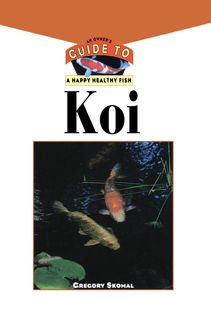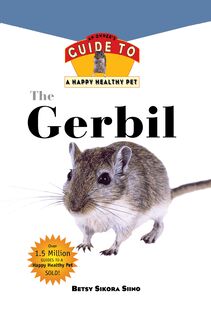-
 Univers
Univers
-
 Ebooks
Ebooks
-
 Livres audio
Livres audio
-
 Presse
Presse
-
 Podcasts
Podcasts
-
 BD
BD
-
 Documents
Documents
-
- Cours
- Révisions
- Ressources pédagogiques
- Sciences de l’éducation
- Manuels scolaires
- Langues
- Travaux de classe
- Annales de BEP
- Etudes supérieures
- Maternelle et primaire
- Fiches de lecture
- Orientation scolaire
- Méthodologie
- Corrigés de devoir
- Annales d’examens et concours
- Annales du bac
- Annales du brevet
- Rapports de stage
La lecture à portée de main
Vous pourrez modifier la taille du texte de cet ouvrage
Découvre YouScribe en t'inscrivant gratuitement
Je m'inscrisDécouvre YouScribe en t'inscrivant gratuitement
Je m'inscrisEn savoir plus
Vous pourrez modifier la taille du texte de cet ouvrage
En savoir plus

Description
PART ONE: ABOUT GERBILS.
1. What Is a Gerbil?
2. Gerbils As Pets.
PART TWO: CARING FOR YOUR GERBILS.
3. Choosing and Preparing for Your Pet Gerbils.
4. Bringing Your Gerbils Home.
5. Housing Your Gerbils.
6. Feeding Your Gerbils.
7. Keeping Your Gerbils Healthy.
PART THREE: ENJOYING YOUR GERBILS.
Understanding Your Gerbils.
9. Fun with Your Gerbils.
PART FOUR: BEYOND THE BASICS.
10. Resources.
Sujets
Informations
| Publié par | Turner Publishing Company |
| Date de parution | 27 août 2007 |
| Nombre de lectures | 0 |
| EAN13 | 9780470253052 |
| Langue | English |
| Poids de l'ouvrage | 2 Mo |
Informations légales : prix de location à la page 0,0800€. Cette information est donnée uniquement à titre indicatif conformément à la législation en vigueur.
Extrait
The
Gerbil
Howell Book House
IDG Books Worldwide, Inc.
An International Data Group Company
Foster City, CA Chicago, IL Indianapolis, IN New York, NY
Howell Book House IDG Books Worldwide, Inc. An International Data Group Company 919 E. Hillsdale Boulevard Suite 400 Foster City, CA 94404
Copyright © 2000 Howell Book House
Copyright © 2000 all photography by Eric Ilasenko
All rights reserved. No part of this book may be reproduced or transmitted in any form or by any means, electronic or mechanical, including photocopying, recording, or by any information storage and retrieval system, without permission in writing from the Publisher.
Howell Book House is a trademark of of IDG Books Worldwide, Inc.
For general information on IDG Books Worldwide’s books in the U.S., please call our Consumer Customer Service department at 800-762-2974. For reseller information, including discounts and premium sales, please call our Reseller Customer Service department at 800-434-3422.
Library of Congress Cataloging-in-Publication Data Siino, Betsy Sikora The Gerbil/by Betsy Sikora Siino p.cm—(An owner’s guide to a happy healthy pet) Includes bibliographical references ISBN: 1-58245-156-7
Library of Congress Catalog Card Number: 97-071179
Manufactured in the United States of America 10 9 8 7 6 5 4 3 2 1
Series Director: Susanna Thomas Book Design by Michele Laseau Cover Design by Iris jeromnimon External Features Illustration by Shelley Norris Photography: All photography by Eric Ilasenko Production Team: David Faust, Heather Gregory, and Heather Pope
Contents
part one
About Gerbils
1 What Is a Gerbil?
2 Gerbils As Pets
part two
Caring for Your Gerbils
3 Choosing and Preparing for Your Pet Gerbils
4 Bringing Your Gerbils Home
5 Housing Your Gerbils
6 Feeding Your Gerbils
7 Keeping Your Gerbils Healthy
part three
Enjoying Your Gerbils
8 Understanding Your Gerbils
9 Fun with Your Gerbils
part four
Beyond the Basics
10 Resources
part one
External Features of the Gerbil
chapter 1
What Is a Gerbil?
You’re probably well aware a gerbil is one of those cute furry little animals that inhabit countless elementary school classrooms and children’s bedrooms from coast to...well...almost coast, right? Simple. But it isn’t that simple. Delve a bit deeper into the world of the gerbil, and you indeed find a cute furry little animal, but one who also happens to boast an endearing personality, a fascinating social structure, and a charter membership in one of the animal kingdom’s largest and most successful families. Once you know all there is to know about this wee critter, you may find that you’re even more anxious to invite one, preferably two, to share your home.
Meet the Rodent Family
Before we get to know the gerbil, it’s wise first to get to know the illustrious family to which he belongs: the rodent family. It’s amazing to ponder the fact that approximately half the planet’s mammals are rodents—a testament to both their rapid breeding rates and their resilience in the face of heavy eradication by most of the world’s predators (particularly the human predator) since mammals first walked the earth. Given their numbers and their survival skills, were the world’s rodents to join forces and decide to take over Mother Earth, they might just succeed. Scary thought, eh?
The word rodent comes from the Latin word rodere, which means “to gnaw.” That is your first clue as to what is probably the most profound shared characteristic of this family—not to mention the characteristic with which those who have found their kitchens infiltrated by mice are intimately familiar. These critters are graced (or cursed, depending on your point of view) with amazing incisor teeth.
The gerbil is a member of the resilient rodent family, with incisors that grow throughout his life.
These teeth, the rodent’s most valuable tools, continue to grow throughout the animal’s life, permitting him to retrieve food wherever it may be, from the interior of a nut’s hard shell, to the contents of a cardboard breakfast cereal box in the pantry. They also come in handy for basic construction work: for tearing into a wall of your home, for example, to gain access to a warm garage where you store your supply of dog food in a heavy plastic airtight container, which won’t be airtight for long. By grinding against tooth surfaces on the lower jaw, the incisors remain sharp as razors and ready to tackle anything the rodent deems chewable, which would include most items and materials he encounters in his daily life.
The ever-growing incisors are a marvel, a true miracle of nature, and the key to a rodent’s survival, but so must they be constantly maintained. The rodent just plain enjoys gnawing, even when it would seem to us that no culinary reward lies at the end of his efforts, as occurs when he gnaws with abandon on a stray block of wood or a cardboard tube placed in his cage. But beneath that enjoyment, he also knows inherently that he must gnaw to keep his teeth, his prized possessions, honed and healthy. Allowed to grow without benefit of maintenance gnawing, those incisors will just keep on growing, resulting in an animal who cannot eat and who suffers great pain from overgrown, possibly skin-piercing, choppers.
The reproductive capabilities of rodents have made them excellent survivors through the ages.
Also phenomenal are the rodents’ performances in the breeding department. Most reach breeding age within weeks of their birth, and from then on, if proximity and housing permit, they will reproduce at incredible rates. Some will even raise two large litters only weeks apart in age at the same time. Wild rodent species have withstood drought, famine, habitat destruction, high-tech extermination efforts, temperature extremes—the whole gamut—and there’s no doubt these animals’ reproduction capabilities are what have kept them so prosperous and so populous, often exasperatingly so. Our species has attempted for centuries to drive many rodent species to extinction, but to no avail.
Despite the frustrations they can cause us—and the money we spend in our attempts to eradicate them—deep down we can’t help but admire the profound adaptability of rats, mice, hamsters and such that comprise the rodent family. These are certainly not the most beloved animals on the planet. One might even venture to suggest that they, as a family, are the most reviled, primarily because many of them—unlike equally reviled snakes and other animals—live in such close proximity to humans. Many a rodent species learned ages ago that life could be easier when shared with humans, whether the humans wanted to share or not (and most humans would rather not). Though their brains are small, these are sharp creatures and world-class opportunists. They know what must be done to survive, and they’re willing take any drastic steps necessary to ensure they do just that. And they always will. We might as well admit it: Where survival is concerned, rodents are the dominant clan.
Gerbil As Rodent
On the rodent spectrum, the gerbil in his natural wild state is a unique entity among his rodent brethren. The gerbil we speak of here is the Mongolian gerbil, the one species of the almost ninety known gerbil species that we humans have deemed to be an appropriate pet.
Mongolian gerbils were unknown to humans until their discovery in Eastern Mongolia by European explorers in 1867, so we have not known this critter long. Therefore, unlike many of his rodent cousins—the mouse and rat, for example, to whom the gerbil is closely related in his pet role—the gerbil’s evolution has not developed in a long and arduous process alongside that of the human species. Nevertheless, get to know the gerbil, and you’ll soon understand just why we chose to offer this humble, relatively unassuming rodent a formal invitation to join our households. You’ll soon see him for the unique entity, the special member of both the rodent family and the pet family, that he is.
The Mongolian gerbil, named of course, for the region in which he was originally discovered, is a proud member of his own illustrious family within the larger family of rodents. This smaller group—also known as jirds, an Arabic word used to describe desert rodents—is comprised of those aforementioned ninety species that hail from various, usually arid, desert regions of Asia, the Middle East and Africa.
Most of these unique creatures, without human intervention or pressures, have evolved into some rather interesting animals. In a relatively short period of time, through a combination of experience with captive gerbils and limited research into wild gerbils, we have gained a fairly clear view of who the Mongolian gerbil is. On the other hand, most of the other species of gerbils and jirds have remained somewhat elusive (the exception being those few, such as the Shaw’s jird, who are beginning to find homes with experienced gerbil keepers). It’s a safe bet that even though some of these more unusual, and typically expensive, species have been “tried” as pets by gerbil keepers who know their Mongolian cousins, most gerbil and jird species would prefer to retain their elusive, free-roaming status.
Most pet gerbils today are descendants of Mongolian gerbils discovered in 1867.
A Unique Mongolian
As for our Mongolian friend, he is known to more scientifically minded folks as Meriones unguiculatus, to purists as the Clawed Jird, and to romantics fluent in Latin as “Little Clawed Warrior.” Despite the latter title—which the species may have earned when someone witnessed the vicious battles that can ensue when a strange gerbil is introduced into another gerbil’s established territory—the Mongolian gerbil is actually a quiet, gentle, friendly, relatively clean creature with kangaroo-like hind legs (for jumping away from and kicking sand in the faces of predators) and a long tail. Would-be rodent owners often do no
-
 Univers
Univers
-
 Ebooks
Ebooks
-
 Livres audio
Livres audio
-
 Presse
Presse
-
 Podcasts
Podcasts
-
 BD
BD
-
 Documents
Documents
-
Jeunesse
-
Littérature
-
Ressources professionnelles
-
Santé et bien-être
-
Savoirs
-
Education
-
Loisirs et hobbies
-
Art, musique et cinéma
-
Actualité et débat de société
-
Jeunesse
-
Littérature
-
Ressources professionnelles
-
Santé et bien-être
-
Savoirs
-
Education
-
Loisirs et hobbies
-
Art, musique et cinéma
-
Actualité et débat de société
-
Actualités
-
Lifestyle
-
Presse jeunesse
-
Presse professionnelle
-
Pratique
-
Presse sportive
-
Presse internationale
-
Culture & Médias
-
Action et Aventures
-
Science-fiction et Fantasy
-
Société
-
Jeunesse
-
Littérature
-
Ressources professionnelles
-
Santé et bien-être
-
Savoirs
-
Education
-
Loisirs et hobbies
-
Art, musique et cinéma
-
Actualité et débat de société
- Cours
- Révisions
- Ressources pédagogiques
- Sciences de l’éducation
- Manuels scolaires
- Langues
- Travaux de classe
- Annales de BEP
- Etudes supérieures
- Maternelle et primaire
- Fiches de lecture
- Orientation scolaire
- Méthodologie
- Corrigés de devoir
- Annales d’examens et concours
- Annales du bac
- Annales du brevet
- Rapports de stage













